
Bee's Training Journey

Introduction
My name is Jennifer Stephenson, and I am a volunteer service dog trainer for the Hounds and Heroes program. After fostering and training Major, one of the Fab Five puppies, I didn't think I would take on another puppy. They are a lot of work! A couple of things changed my mind. Our senior grey, Foreman, has anxiety and severe resource guarding and sleep startle, common among ex-racers. He and his house mate Coal Miner were adopted together, which eliminated some (but not all) of their perceived competition for resources. When Major entered our household at three months old, he quickly acclimated to his lower rank in the pack and was never a "threat" to Foreman. As Major grew up, he and Foreman were as friendly as we'd ever seen Foreman be with another dog.
We recently lost our beloved Coal Miner to leukemia, and since then have debated whether or not to introduce another greyhound to Foreman. We have fostered other greys over the years, and it has been a stressful time for our senior boy and therefore for us. Remembering how well Foreman adjusted to Major, my husband and I discussed bringing home another greyhound puppy to raise alongside Foreman. The rest is history!
Training Log - Month 7
I made a lot of changes to Bee's routine, and we had a much better month:
-
Bee can now roam the house with less supervision. She still gets into mischief here and there, but she enjoys being able to move about more freely.
-
I've loosened the reigns in the back yard, unleashing her and allowing her to explore more and even nibble on grass and weeds. I've come to terms with the fact that she has a strong prey drive and explores with her nose and mouth. When she becomes obsessed with rock hunting, and to avoid another costly and painful surgery, I muzzle her. Otherwise she is free to explore, munch, run and play.
-
I've increased the length of our daily walks, which we both love.
-
I've arranged a couple of play dates for Bee, as she loves spending time in the company of other dogs.
-
I continue to introduce her to new public venues. She is still a delight in public in both personality and behavior.
Toward the end of this training month, I began working with service dog candidate Ace. Having Bee and Ace side by side has proven difficult to navigate, but I believe the excitement of daily encounters with Ace will ease and that she will eventually not be such a big distraction to him.
I've been adding to Bee's list of service dog commands so that she can demonstrate them at upcoming veteran events or when questioned in public. In addition to Cover, she has learned Front and Watch my Six. Up next is Block!
Chase with Dad in the back yard.

Eyes on me and ears on the noisy car wash.

Playdate with a neighbor dog!
Awesome car sticker!
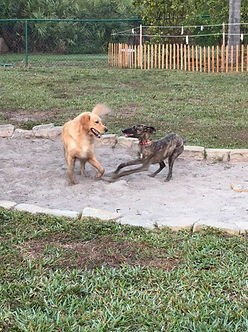

Training Log - Month 6
The best word to describe this past month is...frustrating. Looking back at the month as a whole, I can appreciate the overall improvement in Bee's behavior and skills. Zoom in on any one day, however, and the individual data points are skewed either very high or very low. On good days she's attentive, eager to train, playful and rests well. On other days Bee wakes up and decides to test all of my limits. She's unsettled, whiny, inattentive, challenging and doesn't sleep well. A real Beenager! My best guess is that this is a combination of boredom, growing/teething pains and her testing me. Lately, I wake up and immediately wonder, Which Bee am I getting today?
A quick update on Leave-it training:
1. Back yard - not a lot of improvement here. Leave It, Come, Do Nothing and other training continue throughout the day. Grade: C+.
2. Kitchen - She is no longer counter-surfing and is much improved on her kitchen mat training, except for the occasional lunge toward a crumb (typically on one of her "bad days"). Grade: B
3. Walks - Bee is doing so well on walks that she has graduated from the training collar. There was a slight regression afterwards, but she's still holding strong with longer walks that include off-roading. She's very attentive and responsive to verbal commands and corrections. Grade: A
Public access training for Bee has been a joy. A joy for her because she loves new sensory experiences and loves to meet other people and animals. A relief for both of us from a daily routine that is becoming stale. A joy for me, because these outings wear out my little Bee! Until her personalized vest arrives, she is wearing a generic service dog vest and is learning that she may not interact with people when vested. My goals in training Bee in public are not the same as with the other Hounds and Heroes service dog candidates. I want to strengthen her public behavior for her role as a future service dog ambassador. This way, when she meets a veteran at an event, she won't be overwhelmed by the new environment, she will lay for long periods on her mat, wait for the Make a Friend command and demonstrate a few PTSD and mobility commands. Since she won't be an actual service dog, Bee does not need to train in a grocery store or at a restaurant. Rather, our social outings include large warehouse stores, malls, crowded venues and the like.
In addition to Cover, a PTSD response Bee nailed as a tiny puppy, I have begun training her on Front (standing in front of me) and Watch my Six (stand at my side facing the rear). We practice these in the house, on walks, in the back yard and now in public. She is getting there! She also gives a kiss (aka nose boop on my face) and gives an excellent fist bump. Bee loves to train and earn kibble, but she also gets tons of play time. Her favorite activities are retrieving a ball, tugging, digging in her sandpit and play dates.
Bee loves to dig in her sand pit!
Public, vested training at a bookstore - good focus!
Off-leash training in the back yard...on an attentive day.
Play date with Honor!

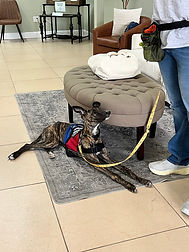


Training Log - Month 5
This has been a very challenging training month with Bee, with nearly all of my energy spent on one area of training: LEAVE IT.
I focused on three areas where Bee needs a lot of self-control: the back yard, the kitchen and on walks.
1. Back yard - To avoid a repeat of her emergency surgery and until she learns to control her instincts and urges to consume everything in the back yard, Bee is almost always leashed when taken outside for potty breaks. Even though the yard is fenced in, this lessening of her freedom gives me the control I need to strengthen her Leave it and Drop it responses. Additionally, I sit with Bee on a blanket - picnic style - in the back yard every single day. The object of this drill is to lay near rocks, grass, weeds, frogs, lizards, bugs and the like and do nothing. I reward her sporadically for laying with me, and she usually stays one to two hours without attempting to leave the blanket. Progress! I let her off leash a couple of times a day to run zoomies, re-leashing her when she loses interest in playing or when she begins hunting in the grass. Grade: C (edited from a B)
2. Kitchen- Not only is Bee always sniffing for crumbs and lunging at dropped food, but she has become a counter surfer. She has a training mat in the kitchen that she must remain on at all times while I cook or clean. She is improving on her ability to hold a Down Stay until released. The biggest issue is that Bee is constantly getting up from rest or play to hunt for food in the kitchen. I decided to add a baby gate to keep her out while continuing to train her for short intervals on the mat, work on her Four on the Floor training for counter surfing and other jumping issues, and maintain my sanity. This has helped tremendously. She has stopped walking toward the kitchen and she waits patiently at the kitchen gate when I am prepping her food. I invite her into the kitchen several times a day, cue her to immediately go to her mat, then do some work while she holds a Down Stay. We have a long way to go. Grade: C-
3. Walks - What an improvement I have seen from Bee's previous nose-to-the-ground walking over the last two months. With a pronged training collar and rewards for eye contact (Focus), Bee has become a very good walker. She is only minimally and briefly distracted by passing people, dogs or vehicles. I took her to the beach, Tractor Supply and Lowe's, where she was able to maintain eye contact despite all of the new sights and sounds of these expansive places. Good girl!! Grade: A
I hope to begin more public access training soon, am just waiting (patiently) on her service vest! In the meantime, Bee will go at least once a week to a public venue to train.
Down-Stay training at Lowe's

Do-Nothing training in the back yard

Bee's first Christmas - so curious!
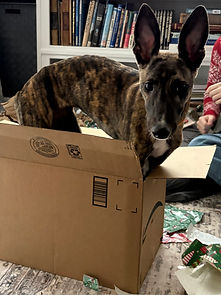
Bee loves her family and is extremely playful and affectionate with us all!

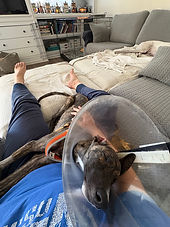

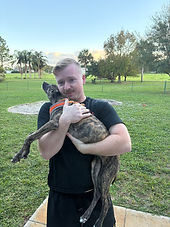
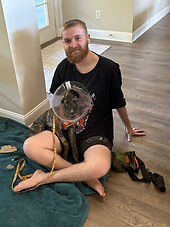
Training Log - Month 4
Bee is growing like a weed and is a sponge for new skills. She is also proving extremely intuitive, regularly guessing what I want from her and trying to please...and earn kibble. Here are the trials and tribulations of training this past month.
Leave it / Drop it
My primary challenge with Bee is that she eats things she shouldn't...worms, tree frogs, lizards, pebbles, leaves, sticks, acorns, floor debris and so much more. This behavior stems from her strong prey drive, her teething pain and her natural puppy curiosity. Though she is NEVER unattended, she is so fast and clever that she grabs and swallows things hidden in the grass that I don't even realize are there. Bee became terribly ill this month and had to have emergency surgery to remove an intestinal blockage. The culprit...a handful of pebbles she swallowed right under my nose. I knew I had to prioritize this problem for her health and safety. I had been training Bee on "Leave It" and "Drop It" since day 1, but it was time to up the stakes. Here's my plan to keep Bee's nose out of the ground.
1. Fence within a fence - there are two small areas inside our fenced in back yard that are abundant with seeds, rocks, frogs and lizards. The day we left Bee at the emergency room, John and I went straight to Lowe's and home to install a small picket fence around those zones, where Bee does most of her hunting. This is a temporary safety solution while I strengthen her Leave it and Drop it skills.
2. Powerful reinforcer - Bee is very willing to perform skills for pieces of her daily kibble, but in a matchup between a piece of kibble and something off the ground, the kibble loses every time. I needed a stronger reinforcer, one that could go head-to-head with a tree frog, rock or acorn, and win Bee's attention every time. With that treat in hand, I put Bee in her training collar and leash and walked around the back yard. She was allowed to sniff the air and near the ground, but the second her nose touched the ground, I issued the cue, "Leave it." Looking at me was the target response, and when she did I immediately marked the behavior with a "Yes!" and gave her the high-value treat. If she did not lift her nose from the ground immediately when cued, I gave a gentle leash correction. If she looked at me after the leash correction, I marked with a "Yes" but offered no treat.
If Bee is able to get something into her mouth - and she is unbelievably fast - I issue the "Drop it" command and offer her the high-value treat. There has only been one occasion so far where she was unwilling to trade, and that was the day she grabbed a tree frog hidden in the grass. I pried open her mouth and pulled out all that was left of that poor soul. Most of the time, she will immediately drop whatever she has in her mouth, and I mark and reward for that behavior with the treat.
By doing these exercises on repeat every day, I am teaching Bee that I am more rewarding than anything she can find on the ground. I offer praise, treats, affection, food, water, toys, stimulation and sleep snuggles. Bee understands this more and more every day. She wears the training collar on her walks and is not permitted to put her nose to the ground at any time. I heavily reward her for good heel work and any time she spontaneously focuses on me or does so after being told to leave it. Eventually, I will be able to issue the Leave it/Drop it commands from a distance and she will immediately comply and give me her attention. But we have a long way to go!
Obedience training
Bee continues to do well with her SMART50 training, which involves her doing good behavior spontaneously and receiving rewards. I now intersperse verbal praise and head scratches with the delivery of treats, and she is still performing well. I also issue basic obedience commands every day that she must perform until released. As a puppy, her attention span is fairly short. So I will add duration and distraction in the weeks to come. The commands that Bee can now perform are Sit, Down, Bed, Stay, Come, Here! (Emergency recall), Heel, Close, Drop it, Leave it, Get it, Bring it, Up, Focus, Touch, Cover, Chin and Shake. She struggles with Stand, but that is because she feels she is doing something wrong by leaving a Down or a Sit. Smart girl!!
Training Log - Month 3
Here are my early training goals with Bee, and how I am tackling them:
1. Potty training
Bee had a UTI and heavy parasite load, which complicated her potty training. So, while she was being treated and until she could hold it for at least a couple of hours, she wore a puppy diaper in the house and was taken outside to "Go Pee" constantly. She was good about letting me know she had to go in the night, and I made two or three sleepy middle-of-the-night trips into the back yard. Thankfully, the meds worked and she began holding it much longer. With only a handful of accidents inside the house, usually when we missed her cues, she mastered potty training very quickly. At 13 weeks of age, she holds it the entire night, and her signals to go are much more recognizable!
2. Teaching her our schedule and household rules
Bedtime, meal times, training and play are all very regimented in our household. My husband and I are fortunate to both work at home, and I am aided by our college-aged son, Quinn, who is also a skilled dog handler and sitter. We have mastered the art of keeping our dogs on a predictable routine on most days, which has proven valuable for our anxious Foreman and all of our other dogs. It was especially helpful during my year-and-a-half of raising and training Major. As predicted, Bee adapted to our schedule with ease. As for the house rules, Bee is learning quickly that the furniture and her people are not teething toys, that she cannot cuddle up and sleep with Foreman and that there are other rules that must be followed.
3. Basic obedience training
I immediately implemented SMART50 training with Bee, a method created by animal behaviorist Kathy Sdao. It stands for See, Mark And Reward Training, and it is suggested that (at least) 50 pieces of kibble are saved and used for capturing your dog doing good behavior. I reserve a full third of Bee's daily kibble allowance, offering it throughout the day as a reward for spontaneously performing desired behaviors such as sitting, laying on her training mat, putting her head on my lap, focusing on me or doing good leash walking. As Bee is highly food-motivated and extremely bright, she picked up on the training immediately. With a solid foundation in place over the first three weeks, I am now also issuing basic obedience commands to increase the duration of her good behaviors and institute a release command. She is performing brilliantly!

11 week-old Bee and me on her gotcha day.

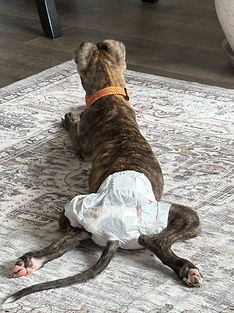
Diapers while on meds and learning to go outside.
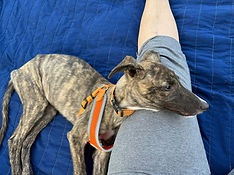
SMART is a highly effective training tool. Instances captured of Bee spontaneously sitting (left), resting her head on my leg (above) and laying down on her training mat (right).

Bee on her first walk with Foreman.
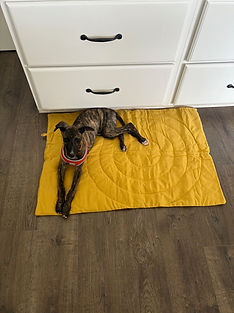

Bee meeting our fearless leader, Barbara, at a November Hounds and Heroes fundraising event.

Bee loves to play and train outside!


